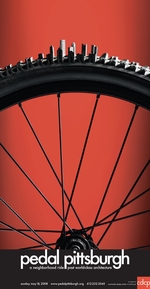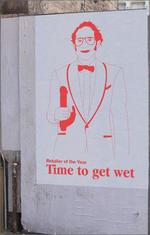Sexy Bakers Revive Office Tea Trolleys – Kellogg’s Nutri-Grain Campaign (VIDEO)
Posted in: Uncategorized (TrendHunter.com) Kellogg’s Nutri-Grain has just launched an online campaign to bring back the office tea trolley, a much missed tradition in the UK.
(TrendHunter.com) Kellogg’s Nutri-Grain has just launched an online campaign to bring back the office tea trolley, a much missed tradition in the UK.
The campaign has a dedicated micro site which allows visitors to create and sign an office petition, view campaign videos and even win a tea trolley for the office (a…
Fox’s Flash Mob Experiment
Posted in: Uncategorized20th Century Fox Australia held a flash mob/ social experiment in Sydney’s Pitt St Mall on the weekend which tied into their new film from M. Night Shyamalan called The Happening.
There is a Freeze Sydney happening next month along the same lines as the Fronzen Grand Central stunt done while ago.
Bit beer: Music in a bottle
Posted in: UncategorizedCheck out the site: http://www.music-in-a-bottle.de/
Find out yourself, how you can make music with your webcam and a bottle of ‘Bit’ beer on our web. In case you don’t have a bottle at hand, an optional way of testing is provided on the site.
Advertising Agency: Jung von Matt/Neckar, Stuttgart, Germany
Creative Directors: Holger Oehrlich, Matthias Kubitz, Joachim Silber, Michael Zölch
Art Directors: Fabian Roser, Kai Heuser, Stefan Roesinger
Copywriters: Kathinka Knoll, Daniel Schweigmann
Programmers: Daniel Hübschmann, Yael Bar-Zeev, Oliver Mueller
Music & Sound: Robert Jedam
Virals Gone Ape – Super Chill Monkey Does Hollywood (VIDEO)
Posted in: Uncategorized (TrendHunter.com) Viral videos are monkeying around in Hollywood! Unbuttonfilms, the same company that brought us the â€Guys backflip into jeans†undercover ad for Levis, has launched Super Chill Monkey Does Hollywood.
(TrendHunter.com) Viral videos are monkeying around in Hollywood! Unbuttonfilms, the same company that brought us the â€Guys backflip into jeans†undercover ad for Levis, has launched Super Chill Monkey Does Hollywood.
One thing’s for sure, director Benzo Theodore loves drama acrobatics. This time he’s fe…
Nature Time-Lapse – Starfish Walking (VIDEO)
Posted in: Uncategorized (TrendHunter.com) After all these years, one of my childhood curiosities is finally being addressed in the form of this time lapse video of a starfish walking.
(TrendHunter.com) After all these years, one of my childhood curiosities is finally being addressed in the form of this time lapse video of a starfish walking.
I grew up playing in tidepools on the west coast, and observing starfish was a part of my summer routine. Regardless of how long I studied them, I never see…
American Apparel’s Dov Charney Awarded Dildo of the Year
Posted in: UncategorizedAmerican Apparel’s Dov Charney Awarded Dildo of the Yera
Posted in: UncategorizedFirst Ever Exhibition To Recognise The Art Of Advertising
Posted in: UncategorizedLONDON – Works by photographers Irving Penn, Nadav Kander and Richard Avedon are among those on show at a new exhibition called Advertising Art.
Avedon’s iconic photograph of model Iman for an Alexon campaign, along with a striking campaign for L’Oreal by Penn, will line up alongside famous images for Silk Cut, Absolut Vodka, Pirelli Tyres and Boddingtons.
Remote Control Pillows – TV Bedding
Posted in: Uncategorized (TrendHunter.com) Since the television has become such an integral part of our household, it was only a matter of time before the remote control ended up tucked in a pillow for an ergonomic TV-watching experience. The organic cotton and hemp pillow comes with an embroidered illustration of a remote and a pocket to pu…
(TrendHunter.com) Since the television has become such an integral part of our household, it was only a matter of time before the remote control ended up tucked in a pillow for an ergonomic TV-watching experience. The organic cotton and hemp pillow comes with an embroidered illustration of a remote and a pocket to pu…
Ogilvy takes centre stage in tonight’s Apprentice
Posted in: UncategorizedLONDON – Ogilvy Advertising will be appearing on BBC One’s smash hit TV series ‘The Apprentice’ tonight, as the teams face the task of designing and creating an ad campaign for a tissue brand.
Apple iTunes: Coldplay Sonic
Posted in: UncategorizedAdvertising Agency: TBWA\Media Arts Lab, USA
Chief Creative Officer: Lee Clow
Executive Creative Directors: Duncan Milner, Eric Grunbaum
Creative Director: Scott Trattner
Art Director: Scott Trattner
Copywriter: Eric Grunbaum
Senior Agency Producer: Mike Refuerzo
Production Co: Anonymous Content
Director: Mark Romanek/Logan
DP: Adam Kimmel
Editorial Co: Nomad Editing Company, Inc
Editor: Glenn Martin
Animation/Design Co: Logan
Visual Effects Co: Mork & Lys
Lead Compositor: Brandon Sanders
Post Co: CO3
Stefan Sonnenfeld, Brian Robinson
Song title: Viva la vida, Coldplay
Animated Birthday Cakes – Celebrate With Moving Food
Posted in: Uncategorized (TrendHunter.com) How fun is this?
(TrendHunter.com) How fun is this?
With the continued media growth of the entertainment, food, and children’s birthday party industries, animated birthday cakes seem to be the product of natural demand progression.
On Coolest-Birthday-Cakes.com, there is a wide selection of themes to choose from. The animated pa…
Familjen Dafgard: Kamasutra
Posted in: UncategorizedAdvertising Agency: Forsman & Bodenfors, Gothenburg, Sweden
Published: May 2008
Whiskas: V for Vendetta
Posted in: UncategorizedThe movie, V for Vendetta, is about the rebellion of a freedom fighter V, who uses terrorist tactics to fight the oppressive society. V takes over the TV station and broadcasts a message to the country condemning the oppressors in parliament. V invites everybody to join him. When V meets Evey for the first time in the movie, he gives a very long speech which consists of words starting with the letter V.
In this radio spot, just like V, cats take over the radio programs to broadcast their messages and they give a long speech which consists of words starting with W.
Advertising Agency: TBWA, Istanbul, Turkey
Creative Director: İlkay Gürpınar
Copywriter: Deniz Ergin, Ece Kaleli
Brand Manager: Sinem Özkan
Producer: Saadet BektaÅŸ
Aired: March 2008
Arena BLM on top in Thinkbox planning awards
Posted in: UncategorizedLONDON – Arena BLM has scooped the top prize at the Thinkbox TV Planning Awards, scooping the Grand Prix award for its Domino’s Pizza campaign.
Movie Ratings on Foreheads – Domestic Violence Ads (GALLERY)
Posted in: Uncategorized (TrendHunter.com) These ads make me a little uncomfortable and evoke great sadness, but making an emotional connection is crucial in awareness ads. This campaign for the National Centre for Domestic Violence sheds light on the emotional and psychological trauma inflicted on children subject to witnessing domestic vio…
(TrendHunter.com) These ads make me a little uncomfortable and evoke great sadness, but making an emotional connection is crucial in awareness ads. This campaign for the National Centre for Domestic Violence sheds light on the emotional and psychological trauma inflicted on children subject to witnessing domestic vio…
Unsolicited Ad Advice for Barack and Hillary
Posted in: UncategorizedEconobox Comeback – Gas Prices Drive Demand For Retro Eco-Cars
Posted in: UncategorizedWhile all the giant automotive manufacturers are feverishly developing fancy new eco-friendly, green and hybrid cars, another trend is quietly brewing: used econoboxes from the ’80s and ’90s! That’s right!
Remember the Geo Metro, Ford Festiva, Toyota Tercel or, my personal favourite, the Honda C…
Content Proposes to Advertising. Advertising Accepts.
Posted in: UncategorizedAccording to Ad Age, Hollywood’s oldest talent shop, the 110-year-old William Morris Agency, is partnering with a triumvirate of digital media, wireless and advertising executives to create a joint venture called Agency 3.0, a digital-marketing-services company seeking to marry digital technology to strategically developed content.
The new venture aims to “bring the ad dollars that much closer to the creative process,” said Greg Johnson, a former chief creative officer at McCann Worldgroup and Digitas.
Another partner, Steve Stanford, who created rival talent agency ICM’s digital media group, said, “Today, a show that has sponsors already in place has a much better chance of airing.”
The team will be based at William Morris’ Beverly Hills headquarters.






